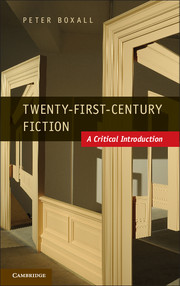Book contents
- Frontmatter
- Dedication
- Miscellaneous frontmatter
- Contents
- Illustrations
- Acknowledgements
- Introduction Twenty-First-Century Fiction
- 1 Late Culture in the Early Twenty-First Century
- 2 Inheriting the Past
- 3 The Limits of the Human
- 4 A Curious Knot
- 5 Sovereignty, Democracy, Globalisation
- Conclusion The Future of the Novel
- Notes
- Bibliography
- Index
1 - Late Culture in the Early Twenty-First Century
Published online by Cambridge University Press: 05 July 2013
- Frontmatter
- Dedication
- Miscellaneous frontmatter
- Contents
- Illustrations
- Acknowledgements
- Introduction Twenty-First-Century Fiction
- 1 Late Culture in the Early Twenty-First Century
- 2 Inheriting the Past
- 3 The Limits of the Human
- 4 A Curious Knot
- 5 Sovereignty, Democracy, Globalisation
- Conclusion The Future of the Novel
- Notes
- Bibliography
- Index
Summary
For last year’s words belong to last year’s language
And next year’s words await another voice.
T. S. Eliot, ‘Little Gidding’In the early years of the twenty-first century, many of the senses by which we orient ourselves have failed, or seemed to fail, leaving us uncertain both of our whereabouts, and of our heading. Like children graduating from junior school, we find ourselves no longer part of an aging culture, no longer the oldest and wisest in the playground, but suddenly fledglings once more, nervously trying to find our way around. The grand historical narratives of western modernity, which led us to believe that we were a venerable people, a people with most of our history behind us, seem suddenly to have yielded to the realisation that we are still young, a culture at the beginning of a new era, for which we have no measure, and no chronological apparatus.
The devices by which we navigate both time and space, of course, have become exponentially more precise over the last decades. With the advent of global positioning systems and mobile phones and satellite maps and radio clocks it seems increasingly difficult to imagine getting lost; but it is partly the development of a new technological regime for the production of global time and space that has led to this disorientation, this apprehension of a new time in which it is impossible to find one’s bearings. There has been, Paul Virilio writes, a ‘havoc wreaked’ upon ‘the orientation of human activities’, by the very technological devices and forms of global communication that are designed to help us find our way around in the world. We find ourselves in the midst of a time which is fundamentally removed from the space-time complexes which had determined the passage of history from the seventeenth to the twentieth century.
- Type
- Chapter
- Information
- Twenty-First-Century FictionA Critical Introduction, pp. 19 - 39Publisher: Cambridge University PressPrint publication year: 2013

